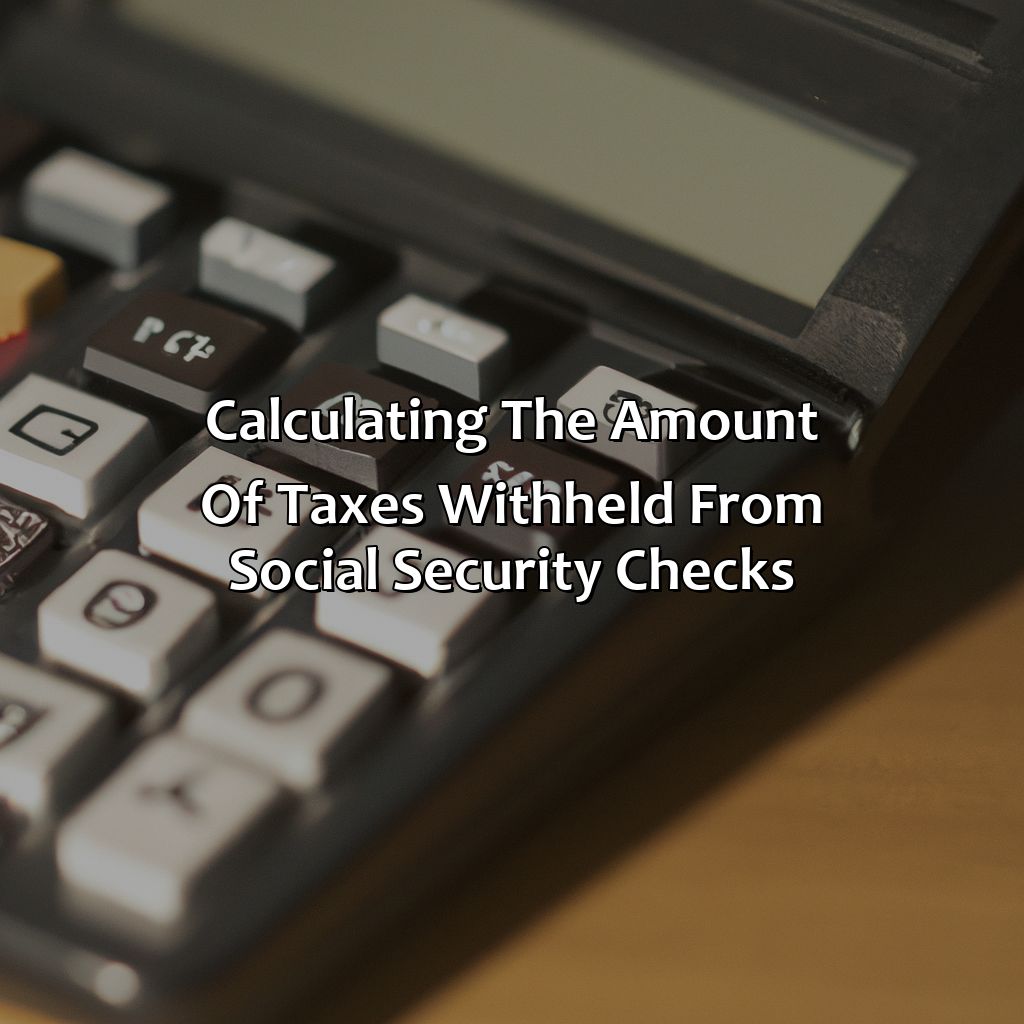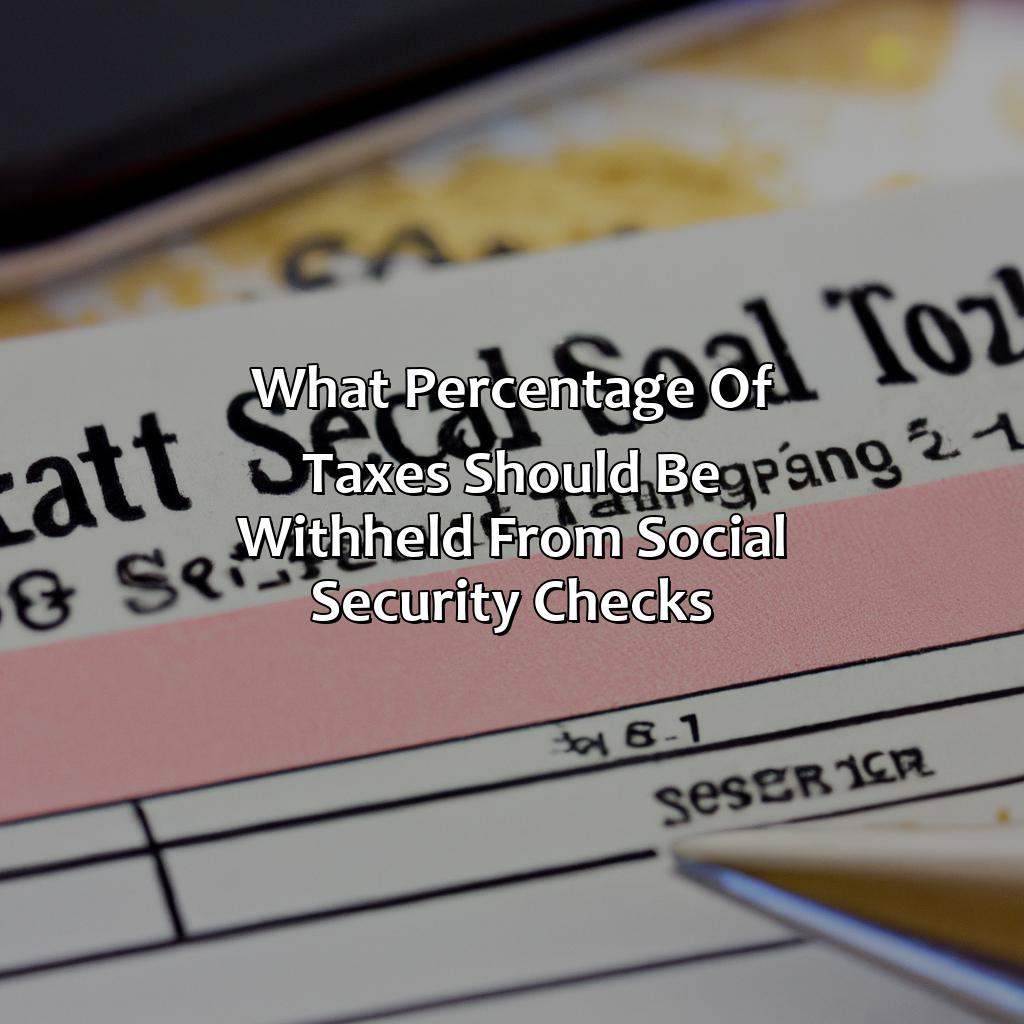What Percentage Of Taxes Should Be Withheld From Social Security Checks?
Key Takeaway:
- The percentage of taxes withheld from Social Security checks depends on several factors, including personal circumstances, income tax bracket, and marital status.
- Social Security taxes include Medicare and Social Security withholding taxes, which can vary based on income and other factors, with higher income earners generally paying more in taxes.
- To calculate the amount of taxes withheld from Social Security checks, individuals can use either the W-4V form or an online withholding calculator, taking into account their specific personal circumstances and tax bracket.
Are you worried about the amount of taxes being taken out of your social security check? Discover how much taxes should be withheld from your income and save money this tax season. You will be empowered to make informed decisions and make the most of your retirement savings.
Percentage of Taxes Withheld from Social Security Checks
You need to understand the percentage of taxes taken from your social security checks. Here, we’ll explain the basics of social security and the two types of taxes that get withheld. These sub-sections will help you learn about the size and scope of taxes taken from your check.
Get ready to understand the taxes taken from social security!

Image credits: retiregenz.com by Harry Duncun
Explanation of Social Security
Social Security is a government program that provides financial support to retired, disabled, and deceased workers and their families. It is funded through payroll taxes that are withheld from employees’ paychecks. The Social Security Administration manages the program’s payments and eligibility requirements.
When workers reach retirement age or become disabled, they may be eligible for monthly Social Security benefits based on their earnings history. Spouses, dependents, and survivors may also be eligible for benefits. These payments are designed to provide a basic source of income in retirement or during periods of disability.
It is important to note that not all Social Security payments are subject to federal income tax. The amount of tax owed depends on the recipient’s combined income (including wages, pensions, and investment income), as well as their filing status.
Pro Tip: To avoid owing too much or too little in taxes on Social Security benefits, recipients can use the IRS withholding calculator to determine how much should be withheld from each payment.
Get ready to have a tax-attitude adjustment as we dive into the different types of taxes that Uncle Sam withholds from your Social Security checks.
Types of Taxes Withheld from Social Security Checks
Social Security Checks-Withheld Taxes Types
There are several types of taxes that can be withheld from social security checks:
- Federal Income Tax
- State Income Tax
- Medicare Tax
- Social Security Tax
- Railroad Retirement Taxes
Federal and state income taxes are calculated based on the recipient’s income level, while Medicare and Social Security taxes are standard deductions. Additionally, railroad retirement taxes can be deducted if applicable.
It is important to note that the amount withheld for each tax may vary depending on the recipient’s location and other factors.
According to the Internal Revenue Service (IRS), those who earn over a certain amount must pay federal income tax on their social security benefits.
A true fact: The IRS requires banks to report any interest earned on a bank account with an annual interest rate of more than $10 so that it can be taxed appropriately.
Get ready to delve into the exciting world of tax law and all the thrilling factors that affect your withholding. Strap in, folks.
Factors that Affect Tax Withholding
Want to understand how tax withholding is impacted? To know, you need to comprehend tax regulations. Break down the factors like personal circumstances, income tax bracket, and marital status. This way, you can assess how each affects the percentage of taxes withheld from your social security check. Then you can find a tailored solution for your unique situation.

Image credits: retiregenz.com by David Washington
Personal Circumstances
Individual situations can impact the proportion of taxes that should be withheld. Factors such as marital status, employment status, and wage amounts can influence tax withholding requirements. Some individuals may qualify for exemptions or deductions, reducing the amount of taxes to withhold. It is essential to evaluate these circumstances and consult with a financial expert when determining appropriate tax withholding amounts.
Moreover, life events can significantly impact tax obligations. Factors like birth, adoption, or marriage can change an individual’s filing status and adjust their overall taxation rate. These changes will require updated tax withholding amounts to reflect the revised coverage adequately.
In particular cases, self-employment income may require additional calculation efforts beyond standard W-4 forms. For independent contractors and business owners who receive quarterly tax statements instead of auto-deducted payments, it may be necessary to calculate annualized estimated taxes accurately.
A true story reflects how personal circumstances affect tax obligations. Jack’s income dropped due to reduced work hours during the pandemic. He anticipated receiving a substantial refund due in part to his qualifying children but later found out he owed more in taxes because he did not adjust his withholding amount appropriately when his hours were cut back in March.
Looks like it’s time to buckle up and prepare for the Income Tax Bracket – the only bracket that ensures we’re all equal in our pain.
Income Tax Bracket
When it comes to calculating income tax, understanding the Income Tax Bracket is crucial. It refers to a range of taxable incomes that are taxed at a specific rate. The higher your income, the higher your tax rate.
The following table shows the Income Tax Bracket:
| Income | Tax Rate |
| $0-$9,525 | 10% |
| $9,526-$38,700 | 12% |
| $38,701-$82,500 | 22% |
| $82,501-$157,500 | 24% |
Knowing your income tax bracket can help you calculate how much you owe in taxes and effectively plan for it. Additionally, certain deductions and credits may also impact your tax bracket.
Ensure you are up-to-date with the most recent tax laws by consulting with a licensed accountant or tax professional. Don’t risk missing out on potential deductions and benefits by neglecting to consult with a professional.
Take control of your finances by proactively learning about the Income Tax Bracket and other crucial financial concepts. By staying informed and properly planning for taxes, you can make smarter financial decisions for yourself and your future.
Saying ‘I do’ may mean less taxes withheld, but it also means more dishes in the sink.
Marital Status
Married couples who file jointly usually have lower tax rates and broader tax brackets than those who file as single filers. Thus, they may need to withhold less money from their paychecks. Whereas, individuals filing as head of household are subject to higher taxes with less income as compared to the other categories.
If you are not sure about which category you should choose or how much you should withhold, consider seeking advice from a professional tax consultant. They can help you estimate your tax liability and suggest appropriate strategies for maximizing your benefits.
In summary, Marital Status determines the rate at which taxes should be paid and withheld. Proper knowledge of applicable tax rates and brackets is crucial in computing the right amount to be withheld from each paycheck. Seeking professional advice can also help ensure that you remain compliant with the laid-down regulations while simultaneously maximizing available benefits.
Get ready to do some math and mourn the loss of that extra slice of cake, because calculating tax withholding from social security checks is about as fun as a root canal.
Calculating the Amount of Taxes Withheld from Social Security Checks
Want to know the right way to calculate taxes taken from Social Security checks? Read the ‘Calculating the Amount of Taxes Withheld from Social Security Checks‘ section. It will help you manage your taxes better. There are two easy methods inside – ‘How to Use the W-4V Form‘ and ‘Online Withholding Calculator‘. Don’t worry, they won’t give you any hassle.

Image credits: retiregenz.com by David Duncun
How to Use the W-4V Form
The W-4V Form is necessary for taxpayers who receive Social Security benefits and choose to have taxes withheld. With the form, individuals can select an amount or percentage of their benefit that they want to withhold from federal taxes. Here’s a helpful six-step guide on how to use the W-4V form.
- Enter your personal information – This includes full name, Social Security number, and mailing address.
- Select the Tax Year – Choose the tax year for which you want taxes withheld from your Social Security benefits.
- Choose Your Percentage or Amount – You may determine either a flat dollar amount or a percentage that will be withheld from each payment. Pick whichever works better for you.
- Certificate in Signature Section should be signed – Before submission of W-4v Form Sign and date the certificate in section 6 of the form.
- Mail the completed form – After verifying all details make sure that it has been mailed to your local Social Security office.
It’s important to remember that individuals without taxable income likely won’t need to have funds withheld, even if they do receive Social Security payments. These non-taxable amounts can refer to sources such as annuities, pensions, and interest on savings accounts. If it turns out that you owe taxes unexpectedly at tax time, there may be penalties for having insufficiently withheld amounts.
To reiterate, using Form W-4V is an essential part of understanding how much money should be withheld from one’s Social Security benefits each year. Failure to include this information could lead to surprises during tax time. Interestingly enough, this process has been in place since 1993 when Congress decided it was essential for taxpayers who receive social security payments to know precisely what portion would be taxed.
Finally, a calculator that won’t judge me for withholding too much (or too little) from my social security check.
Online Withholding Calculator
To calculate the amount of taxes withheld from social security checks, an advanced system called the Digital Withholding Calculator is available. This tool analyzes the taxable benefits that senior citizens receive and deducts the estimated tax due. Not only does it save time, but it also helps individuals avoid underpaying their taxes.
Using this online resource, taxpayers can accurately calculate their withholding amounts without the hassle of manual calculations. The withholding calculator takes into account a retiree’s income streams to provide a highly personalized assessment of how much should be deducted. It also considers various factors, such as filing status and whether any dependents or additional income need to be accounted for.
It is worth noting that taxpayers do not need to use all capital letters when searching for this section on the IRS website.
According to AARP, some states have varying rules regarding social security taxes, so retirees must check with their state withholding agency or seek professional advice before submitting their tax returns.
Five Facts About Withholding Taxes from Social Security Checks:
The amount of taxes withheld from Social Security checks depends on factors such as marital status, income, and number of dependents. (Source: SSA)
Taxpayers can choose to have 7%, 10%, 12%, or 22% of their Social Security benefits withheld for federal income taxes. (Source: AARP)
Taxpayers can submit form W-4V to the Social Security Administration to elect a specific withholding rate. (Source: SSA)
Some states also impose taxes on Social Security benefits, but the rules and rates vary by state. (Source: Kiplinger)
It is important for taxpayers to accurately estimate their tax liability and adjust their withholding as necessary to avoid underpayment penalties or large tax bills at year-end. (Source: IRS)
FAQs about What Percentage Of Taxes Should Be Withheld From Social Security Checks?
What percentage of taxes should be withheld from social security checks?
The percentage of taxes that should be withheld from social security checks depends on your taxable income and filing status. Generally, if your income is below a certain threshold, you may not have to pay taxes on your social security benefits at all.
How do I determine the percentage of taxes to withhold from my social security checks?
To determine the percentage of taxes to withhold from your social security checks, you can use the IRS tax withholding estimator or consult with a tax professional. You will need to provide information about your income and filing status.
What happens if I don’t have taxes withheld from my social security checks?
If you do not have taxes withheld from your social security checks, you may face a tax bill when you file your tax return. Additionally, if you owe a certain amount of taxes, the IRS may garnish your social security benefits to satisfy the debt.
Can I change the percentage of taxes withheld from my social security checks?
Yes, you can change the percentage of taxes withheld from your social security checks by completing Form W-4V. This form allows you to specify the amount of federal income tax you want withheld from your benefit each month.
What is the maximum percentage of taxes that can be withheld from my social security checks?
Currently, the maximum percentage of taxes that can be withheld from social security benefits is 37%. This rate is applied to certain high-income individuals who surpass the income thresholds.
Are state taxes withheld from social security checks?
Whether or not state taxes are withheld from social security checks depends on the state in which you live. Some states do not tax social security benefits, while others may have their own tax withholding rules. Check with your state tax agency for more information.
 Checkout this IRS Loophole
Checkout this IRS Loophole 
